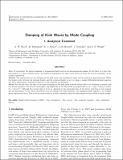Files in this item
Damping of kink waves by mode coupling : I. Analytical treatment
Item metadata
| dc.contributor.author | Hood, Alan William | |
| dc.contributor.author | Ruderman, Michael | |
| dc.contributor.author | Pascoe, David James | |
| dc.contributor.author | De Moortel, Ineke | |
| dc.contributor.author | Terradas, Jaume | |
| dc.contributor.author | Wright, Andrew Nicholas | |
| dc.date.accessioned | 2013-02-07T12:34:45Z | |
| dc.date.available | 2013-02-07T12:34:45Z | |
| dc.date.issued | 2013-03 | |
| dc.identifier | 34921682 | |
| dc.identifier | ba1e0950-ced0-430d-9f19-6f56799c2427 | |
| dc.identifier | 84874067196 | |
| dc.identifier | 000316460600039 | |
| dc.identifier.citation | Hood , A W , Ruderman , M , Pascoe , D J , De Moortel , I , Terradas , J & Wright , A N 2013 , ' Damping of kink waves by mode coupling : I. Analytical treatment ' , Astronomy & Astrophysics , vol. 551 , A39 . https://doi.org/10.1051/0004-6361/201220617 | en |
| dc.identifier.issn | 0004-6361 | |
| dc.identifier.other | ORCID: /0000-0002-1452-9330/work/39526490 | |
| dc.identifier.other | ORCID: /0000-0003-2620-2068/work/58055206 | |
| dc.identifier.other | ORCID: /0000-0002-9877-1457/work/58055403 | |
| dc.identifier.uri | https://hdl.handle.net/10023/3340 | |
| dc.description.abstract | Aims. To investigate the spatial damping of propagating kink waves in an inhomogeneous plasma. In the limit of a thin tube surrounded by a thin transition layer, an analytical formulation for kink waves driven in from the bottom boundary of the corona is presented. Methods. The spatial form for the damping of the kink mode was investigated using various analytical approximations. When the density ratio between the internal density and the external density is not too large, a simple di.erential-integral equation was used. Approximate analytical solutions to this equation are presented. Results. For the first time, the form of the spatial damping of the kink mode is shown analytically to be Gaussian in nature near the driven boundary. For several wavelengths, the amplitude of the kink mode is proportional to (1 + exp(-z2 /L2 g))/2, where L2g = 16/ǫκ2 k2 . Although the actual value of 16 in Lg depends on the particular form of the driver, this form is very general and its dependence on the other parameters does not change. For large distances, the damping profile appears to be roughly linear exponential decay. This is shown analytically by a series expansion when the inhomogeneous layer width is small enough. | |
| dc.format.extent | 14 | |
| dc.format.extent | 842764 | |
| dc.language.iso | eng | |
| dc.relation.ispartof | Astronomy & Astrophysics | en |
| dc.subject | Magnetohydrodynamics (MHD) | en |
| dc.subject | Sun: atmosphere | en |
| dc.subject | Sun: magnetic topology | en |
| dc.subject | Sun: oscillations | en |
| dc.subject | Waves | en |
| dc.subject | QC Physics | en |
| dc.subject.lcc | QC | en |
| dc.title | Damping of kink waves by mode coupling : I. Analytical treatment | en |
| dc.type | Journal article | en |
| dc.contributor.sponsor | Science & Technology Facilities Council | en |
| dc.contributor.sponsor | The Royal Society | en |
| dc.contributor.institution | University of St Andrews. Applied Mathematics | en |
| dc.identifier.doi | 10.1051/0004-6361/201220617 | |
| dc.description.status | Peer reviewed | en |
| dc.identifier.grantnumber | ST/K000950/1 | en |
| dc.identifier.grantnumber | n/a | en |
This item appears in the following Collection(s)
Items in the St Andrews Research Repository are protected by copyright, with all rights reserved, unless otherwise indicated.

